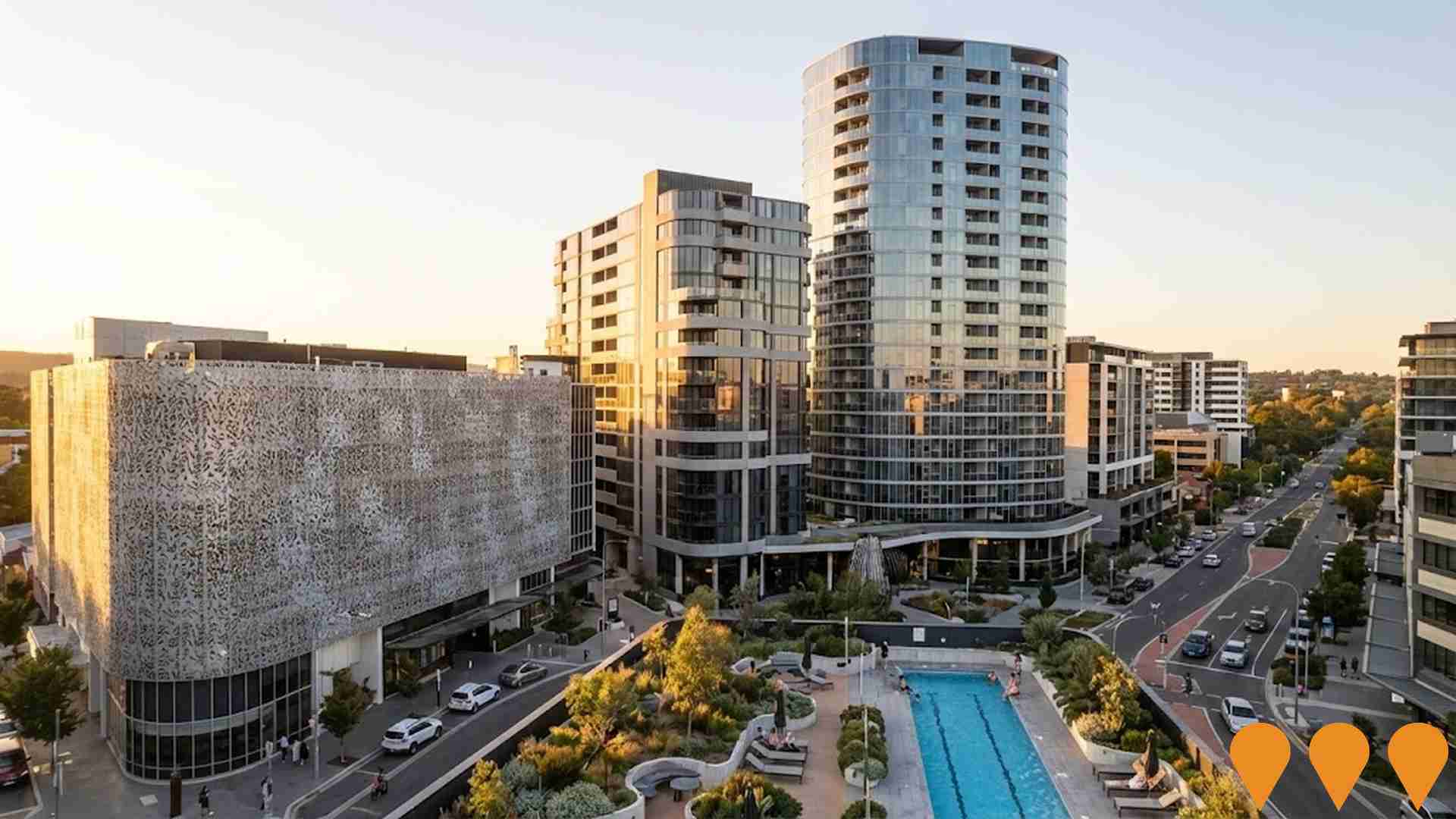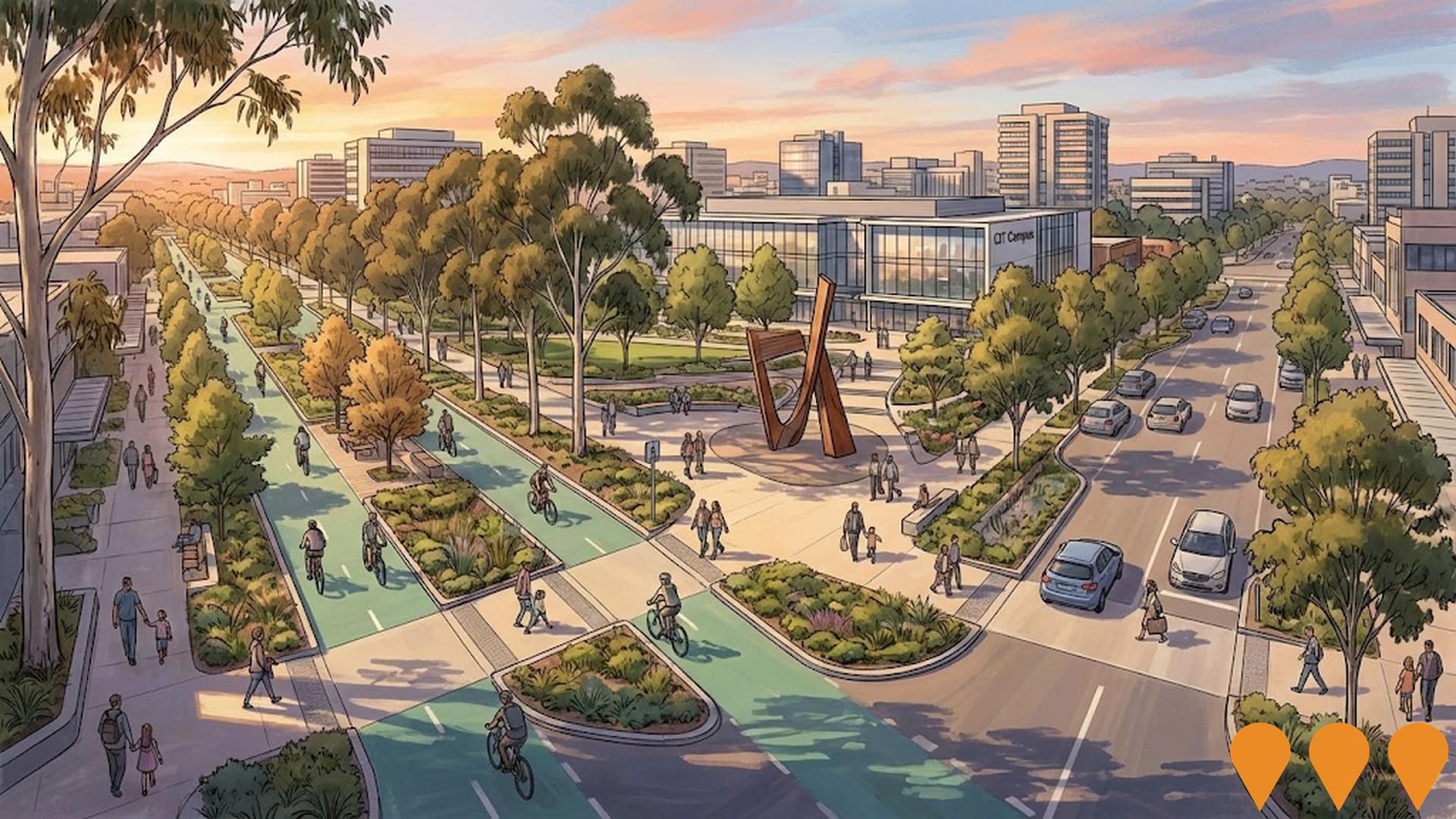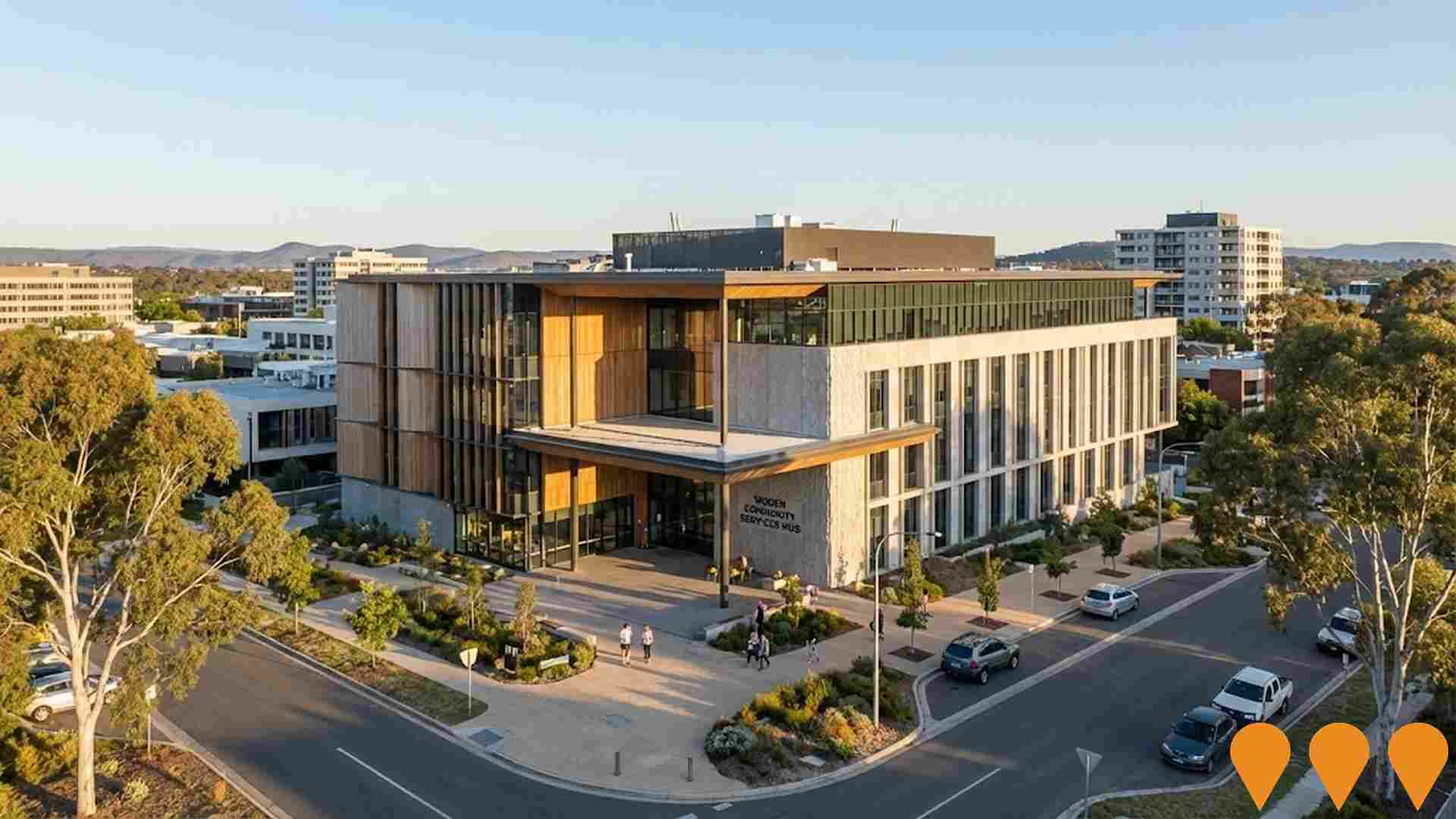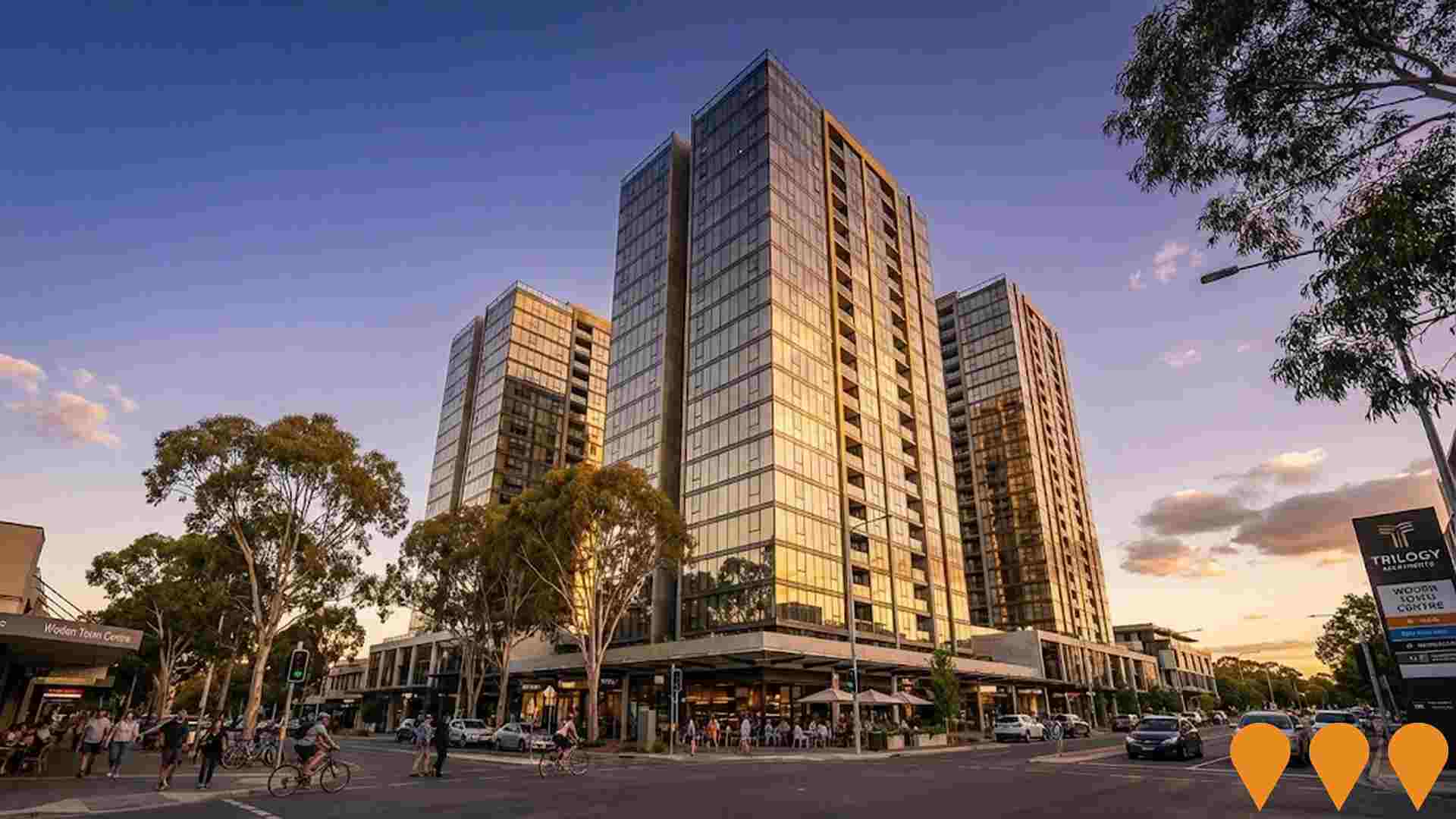Chart Color Schemes
est. as @ -- *
ABS ERP | -- people | --
2021 Census | -- people
Sales Activity
Curious about local property values? Filter the chart to assess the volume and appreciation (including resales) trends and regional comparisons, or scroll to the map below view this information at an individual property level.
Find a Recent Sale
Sales Detail
Population
Population growth drivers in Lyons are strong compared to national averages based on AreaSearch's ranking of recent, and medium to long-term trends
Lyons ACT's population is 3,332 as of Aug 2025. This reflects an increase of 61 people since the 2021 Census, which reported a population of 3,271. The change is inferred from ABS estimated resident population of 3,273 in June 2024 and additional 37 validated new addresses since the Census date. This level equates to a density ratio of 1,474 persons per square kilometer, above national averages assessed by AreaSearch. Overseas migration contributed approximately 76.9% of overall population gains recently.
AreaSearch adopts ABS/Geoscience Australia projections for each SA2 area, released in 2024 with 2022 as the base year. For areas not covered and years post-2032, ACT Government's SA2 area projections with 2022 base are adopted. Future demographic trends suggest a population increase just below median Australian statistical areas by 2041, with an expected increase of 271 persons and 6.4% total growth over the 17 years based on latest numbers.
Frequently Asked Questions - Population
Development
AreaSearch assessment of residential development drivers sees a low level of activity in Lyons, placing the area among the bottom 25% of areas assessed nationally
Lyons has seen approximately 9 new homes approved each year over the past five financial years, totalling 46 homes. No approvals have been recorded so far in FY-26. On average, between FY-21 and FY-25, 0 new residents arrived per new home annually, indicating that supply is meeting or exceeding demand.
The average construction cost of new dwellings was $269,000, which is below regional norms, offering more affordable housing options. Compared to the Australian Capital Territory, Lyons has seen substantially reduced construction activity, at 83.0% below the regional average per person. This constrained new construction typically reinforces demand and pricing for existing properties. The area's established nature is also indicated by its level being under the national average, potentially suggesting planning limitations. New building activity in Lyons consists of 50.0% detached dwellings and 50.0% medium and high-density housing, creating more affordable entry points and suiting downsizers, investors, and first-home buyers. With around 508 people per approval, Lyons indicates a mature market.
By 2041, Lyons is expected to grow by approximately 212 residents. At current development rates, new housing supply should comfortably meet demand, providing good conditions for buyers and potentially supporting growth beyond current population projections.
Frequently Asked Questions - Development
Infrastructure
Lyons has strong levels of nearby infrastructure activity, ranking in the top 40% nationally
The performance of an area can significantly be influenced by changes in local infrastructure, major projects, and planning initiatives. AreaSearch has identified a total of 22 projects that are likely to impact the area. Notable projects include Woden Experiment Stage 2 - Public Realm & Active Travel Upgrades, Trilogy Apartments, Ivy by Morris (Section 54 Phillip), and CIT Woden Campus. The following list details those projects most likely to be relevant.
Professional plan users can use the search below to filter and access additional projects.
INFRASTRUCTURE SEARCH
 Denotes AI-based impression for illustrative purposes only, not to be taken as definitive under any circumstances. Please follow links and conduct other investigations from the project's source for actual imagery. Developers and project owners wishing us to use original imagery please Contact Us and we will do so.
Denotes AI-based impression for illustrative purposes only, not to be taken as definitive under any circumstances. Please follow links and conduct other investigations from the project's source for actual imagery. Developers and project owners wishing us to use original imagery please Contact Us and we will do so.
Frequently Asked Questions - Infrastructure
WOVA Residential Precinct
Four distinctive residential towers with 802 apartments, 54 Abode Hotel rooms, and 22 commercial tenancies. Features resort-style amenities including lap pool, fitness studio, private cinema, and rooftop terraces. Completed 2024.

Woden Town Square Precinct Redevelopment
A major mixed-use urban renewal precinct featuring a new public town square, residential apartments, commercial office space, retail, and community facilities as the centrepiece of Woden's revitalisation.

Woden Experiment Stage 2 - Public Realm & Active Travel Upgrades
Major public realm upgrades including new cycling paths, widened footpaths, tree planting, public art and improved connectivity around the new CIT Campus and town centre.

Woden Community Services Hub
A new four-storey facility in Woden Town Centre that will centralise community and government services under one roof, bringing together services currently operating from multiple buildings in the region. It will include child and family services, other community services, meeting rooms, a multi-purpose hall, and workshop spaces to provide efficient support to residents.

Woden Bus Depot and Transport Interchange
The Woden Bus Depot is completed and operational as Australia's largest electric bus depot, capable of housing and charging up to 100 electric buses with modern maintenance facilities. The Woden Transport Interchange is under construction and will be light rail enabled, featuring improved passenger facilities including wide footpaths, enhanced lighting, shelters, bike storage, toilets, and landscaping for better safety and connectivity.

Trilogy Apartments
Three-tower residential development featuring contemporary design and integrated retail spaces. Contributing to Woden town centre revitalization.

Oaks Arbour Apartments
Modern apartment complex with landscaped courtyards and community facilities. Focus on livability and environmental sustainability.

Ivy by Morris (Section 54 Phillip)
A premium 18-storey residential tower offering 212 apartments with rooftop amenities, ground-floor retail and direct connection to the redeveloped Woden Town Square.

Employment
Employment performance in Lyons exceeds national averages across key labour market indicators
Lyons ACT has a highly educated workforce with prominent representation in essential services sectors. Its unemployment rate was 3.1% as of June 2025, below the Australian Capital Territory's (ACT) rate of 3.4%.
Employment growth over the past year was estimated at 3.7%. In June 2025, 1,886 residents were employed with an unemployment rate of 0.3% lower than ACT's rate. Workforce participation in Lyons was 66.9%, slightly below ACT's 69.6%. Key industries for employment among residents are public administration & safety, health care & social assistance, and education & training.
Lyons has a particular specialization in health care & social assistance, with an employment share 1.4 times the regional level. However, professional & technical services are under-represented at 8.3% compared to ACT's 11.1%. The predominantly residential area offers limited local employment opportunities as indicated by Census data. Between June 2024 and June 2025, employment levels increased by 3.7% while the labour force grew by 1.6%, leading to a 1.9 percentage point drop in unemployment rate. In contrast, ACT experienced employment growth of 1.9% with a 0.3 percentage point decrease in unemployment rate. Jobs and Skills Australia's national employment forecasts from May 2025 suggest potential future demand within Lyons. These projections indicate national employment growth of 6.6% over five years and 13.7% over ten years, with varying rates across industry sectors. Applying these projections to Lyons's employment mix suggests local growth of approximately 6.6%% over five years and 13.6% over ten years, though this is a simple extrapolation for illustrative purposes only.
Frequently Asked Questions - Employment
Income
Income metrics indicate excellent economic conditions, with the area achieving higher performance than 75% of national locations assessed by AreaSearch
Lyons' median taxpayer income was $59,200 with an average of $73,935 according to AreaSearch's postcode level ATO data for the financial year 2022. This is notably higher than Australia's median income of $68,678 and average income of $83,634 during the same period. Projecting forward based on a 13.6% increase from the Wage Price Index since 2022, estimated incomes for September 2025 would be approximately $67,251 (median) and $83,990 (average). Lyons' individual earnings stood out at the 86th percentile nationally with a weekly income of $1,097. The largest segment of residents earned between $1,500 - 2,999 weekly, comprising 30.9% (1,029 residents), which is similar to the surrounding region where this cohort represents 34.3%. Lyons exhibited considerable affluence with 32.7% earning over $3,000 per week, supporting premium retail and service offerings. High housing costs consumed 15.2% of income, yet strong earnings placed disposable income at the 72nd percentile nationally. The area's SEIFA income ranking places it in the 8th decile.
Frequently Asked Questions - Income
Housing
Lyons displays a diverse mix of dwelling types, with a higher proportion of rental properties than the broader region
In Lyons, as per the latest Census evaluation, 51.7% of dwellings were houses while 48.3% consisted of other types such as semi-detached homes, apartments, and 'other' dwellings. In comparison, the Australian Capital Territory had 58.4% houses and 41.7% other dwellings. Lyons' home ownership rate was 27.5%, with mortgaged dwellings at 27.1% and rented ones at 45.4%. The median monthly mortgage repayment in Lyons was $2,383, exceeding the Australian Capital Territory average of $2,167. The median weekly rent in Lyons was $360, compared to the Australian Capital Territory's $440. Nationally, Lyons' mortgage repayments were higher at $2,383 than the Australian average of $1,863, while rents were lower at $360 compared to the national figure of $375.
Frequently Asked Questions - Housing
Household Composition
Lyons features high concentrations of lone person households and group households, with a lower-than-average median household size
Family households constitute 61.2% of all households, including 26.2% couples with children, 25.3% couples without children, and 8.5% single parent families. Non-family households make up the remaining 38.8%, with lone person households at 35.1% and group households comprising 3.9%. The median household size is 2.3 people, which is smaller than the Australian Capital Territory average of 2.4.
Frequently Asked Questions - Households
Local Schools & Education
Lyons demonstrates exceptional educational outcomes, ranking among the top 5% of areas nationally based on AreaSearch's comprehensive analysis of qualification and performance metrics
Lyons has a higher proportion of university-qualified residents aged 15 and above than the Australian average. Specifically, 51.4% of Lyons' residents hold such qualifications, compared to the national figure of 30.4%. This educational advantage is reflected in the types of qualifications held: Bachelor degrees are most common at 26.4%, followed by postgraduate qualifications at 19.3%, and graduate diplomas at 5.7%. Vocational pathways account for 22.8% of qualifications, with advanced diplomas making up 11.1% and certificates 11.7%.
Educational participation in Lyons is notably high, with 29.7% of residents currently enrolled in formal education. This includes 8.2% in primary education, 7.1% in tertiary education, and 6.8% pursuing secondary education. Lyons Early Childhood School serves the local educational needs within Lyons, with an enrollment of 99 students as of a recent report. The school focuses exclusively on primary education, with secondary options available in surrounding areas due to limited local school capacity (3.0 places per 100 residents compared to the regional average of 18.4). This limited capacity means many families travel to nearby areas for schooling. The area demonstrates significant socio-educational advantages and academic achievement, as indicated by its ICSEA score of 1129.
Frequently Asked Questions - Education
Schools Detail
Nearby Services & Amenities
Transport
Transport servicing is good compared to other areas nationally based on assessment of service frequency, route connectivity and accessibility
Lyons has 17 active public transport stops operating within its boundaries. These are served by a mix of bus routes, totalling 8 individual lines that collectively facilitate 1,899 weekly passenger trips. The transport accessibility in Lyons is rated as good, with residents on average located 214 meters from the nearest stop.
Service frequency averages 271 trips per day across all routes, equating to approximately 111 weekly trips per individual stop.
Frequently Asked Questions - Transport
Transport Stops Detail
Health
The level of general health in Lyons is notably higher than the national average with prevalence of common health conditions low among the general population though higher than the nation's average across older, at risk cohorts
Lyons demonstrates above-average health outcomes with a low prevalence of common health conditions among its general population, although this is higher than the national average among older, at-risk cohorts. Approximately 56% of the total population (~1,882 people) has private health cover, compared to 68.1% in the Australian Capital Territory.
The most common medical conditions in the area are mental health issues and arthritis, affecting 8.1 and 7.4% of residents respectively. 70.5% of residents declare themselves completely clear of medical ailments, compared to 70.1% across the Australian Capital Territory. As of 2021, 18.4% of residents are aged 65 and over (614 people), indicating a need for more health attention than the broader population.
Frequently Asked Questions - Health
Cultural Diversity
Lyons is among the most culturally diverse areas in the country based on AreaSearch assessment of a range of language and cultural background related metrics
Lyons has high cultural diversity, with 36.8% of its population born overseas and 30.6% speaking a language other than English at home. Christianity is the dominant religion in Lyons, comprising 36.2% of people, while Buddhism is overrepresented compared to Australian Capital Territory, making up 6.7%. The top three ancestry groups are English (23.2%), Australian (21.0%), and Other (17.3%).
Notably, French (0.8%), Sri Lankan (0.7%), and Polish (1.0%) ethnicities are overrepresented in Lyons compared to regional figures of 0.6%, 0.4%, and 0.8% respectively.
Frequently Asked Questions - Diversity
Age
Lyons's population is slightly younger than the national pattern
Lyons has a median age of 37 years, which is slightly older than Australian Capital Territory's 35 but aligns with Australia's national average of 38. The population aged 85 and above stands at 4.1%, higher than in Australian Capital Territory, while those aged 5 to 14 make up 9.6%. Between 2021 and the present, the percentage of the population aged 55 to 64 has grown from 9.0% to 9.9%. Conversely, the proportion of those aged 25 to 34 has decreased from 19.0% to 16.5%, and the age group 5 to 14 has dropped from 11.0% to 9.6%. By 2041, Lyons' population is projected to see significant demographic shifts. The number of people aged 65 to 74 is expected to increase by 102 individuals (44%), from 234 to 337. Notably, the combined age groups of 65 and above will account for 53% of total population growth, reflecting Lyons' aging demographic trend. In contrast, both the age groups of 0 to 4 and 35 to 44 are projected to decrease in number.



